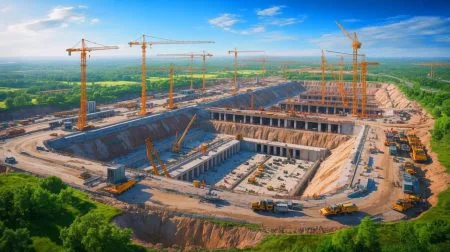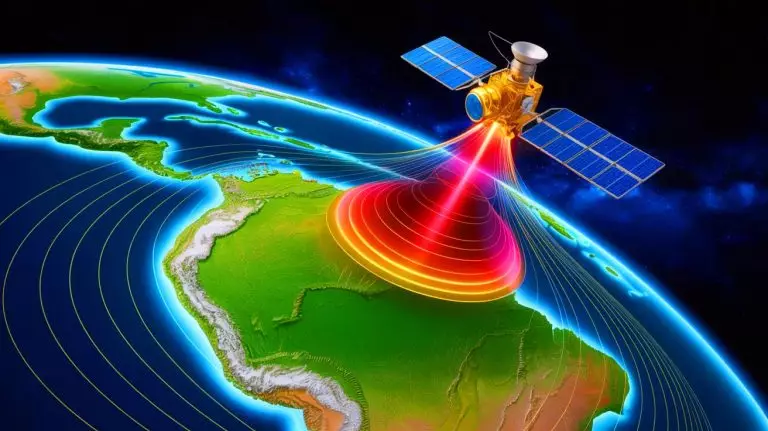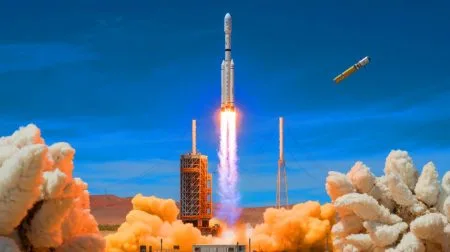| IN A NUTSHELL |
|
The South Atlantic Anomaly (SAA) has become a focal point of scientific intrigue and concern. This vast region of weakened magnetic field over South America and the South Atlantic Ocean presents a unique challenge for NASA and the global scientific community. Originating from complex processes within Earth’s core, the SAA is not only a fascinating natural phenomenon but also a critical area of study due to its potential impact on space technologies. As the anomaly evolves, it becomes imperative to understand its mechanisms and anticipate the challenges it presents to our technological infrastructure.
Deep Origins and Complex Mechanisms
At the heart of NASA’s concerns lies the South Atlantic Anomaly (SAA), a geomagnetic phenomenon both captivating and concerning. This immense region is characterized by a significant reduction in magnetic intensity compared to its surroundings. Far from being a mere scientific curiosity, this weakness acts as a breach in our natural protective shield, allowing high-energy solar particles to dangerously approach Earth’s surface.
The origins of the SAA are intricately linked to the geodynamo, a complex process occurring in Earth’s outer core. Here, the movement of molten iron and nickel generates the magnetic field that envelops us. However, this generation is not uniform. Two primary factors contribute to the formation of the SAA: the tilt of Earth’s magnetic axis relative to its rotational axis and the influence of a massive dense structure known as the African Large Low Shear Velocity Province, located about 1,800 miles beneath the African continent. These factors disrupt the magnetic field generation in this region, leading to a local polarity reversal within Earth’s magnetic field, further weakening the dipole field intensity in this specific area.
A Threat to Space Technology
This magnetic vulnerability poses significant risks to space technology. Satellites traversing the SAA are exposed to high levels of energetic protons, which can cause single event upsets (SEUs). These incidents can lead to temporary malfunctions, data corruption, or even permanent damage if critical systems are affected.
To mitigate these risks, many satellite operators take preventive measures, such as shutting down non-essential systems when passing through the anomaly. Even the International Space Station (ISS) crosses the SAA on each orbit. While its shielding effectively protects astronauts, external instruments remain more vulnerable. Bryan Blair, deputy principal investigator for the GEDI instrument on the ISS, reports occasional “glitches” and resets, resulting in a few hours of data loss each month. Other missions, like the Ionospheric Connection Explorer (ICON), also closely monitor the SAA and adjust their operations accordingly.
Dynamic Evolution and Challenges
The South Atlantic Anomaly is far from static. Recent data, particularly from the ESA’s Swarm constellation and historical measurements from NASA’s SAMPEX mission, confirm several alarming trends. The anomaly is slowly drifting northwest, expanding in surface area, and, as observed since 2020, beginning to split into two distinct lobes, creating two centers of minimum magnetic intensity.
This bifurcation increases the number of hazardous zones for spacecraft and complicates the task of scientists developing predictive models of geomagnetic conditions. Understanding the changing morphology of the SAA is crucial for the safety of current and future satellites. As Terry Sabaka of NASA emphasizes, these developments necessitate continuous monitoring and adaptation in satellite operations to mitigate potential disruptions.
Anticipating the Invisible
To refine their understanding and predictions, NASA combines satellite data with simulations of Earth’s core dynamics. These inputs feed global models like the International Geomagnetic Reference Field (IGRF), which track the evolution of Earth’s magnetic field. These models are essential not only for planning space missions but also for gaining a better grasp of our planet’s internal structure. The approach resembles weather forecasting but on much longer timescales, allowing scientists to estimate the secular variation—the slow yet persistent changes in the magnetic field over years and decades.
While the current evolution of the SAA is unprecedented in the space era, geological records suggest that such anomalies are not exceptional over long timescales. It is important to note that, according to scientists, the current SAA is not an early indicator of a magnetic pole reversal, a natural but rare phenomenon occurring over hundreds of thousands of years. Thus, studying the SAA remains a vital research area, crucial for protecting our orbiting technologies and deepening our understanding of the profound forces driving our planet.
As the South Atlantic Anomaly continues to evolve, the scientific community remains vigilant in its efforts to understand and mitigate its impact. With its potential to disrupt satellite operations and influence our understanding of Earth’s magnetic field, the SAA poses intriguing questions about the future of our planet’s magnetic dynamics. How will these changes shape our technological and scientific pursuits in the years to come?
Did you like it? 4.5/5 (22)








This article is mind-blowing! 🌍 Are we really seeing the start of something big with Earth’s core?
Could the SAA affect human health on the surface? 🤔
I’m skeptical. How do we know this isn’t just a natural cycle? Science often jumps to conclusions. 🤨
This sounds like the plot of a sci-fi movie! When’s the alien invasion? 👽
How long has the South Atlantic Anomaly been known to affect space tech?
Interesting read, but how accurate are these core simulations by NASA?
Thanks for the informative piece. It’s fascinating how much we still have to learn about our own planet!
Is there a connection between the SAA and climate change?
Thank you for shedding light on such a complex topic. More articles like this, please!
What measures are satellite companies taking to mitigate these risks? Would love to know more!
Can these magnetic disturbances affect animals, like migratory birds?
Is the SAA a sign that Earth’s magnetic field is weakening overall?
I’ve never heard of the African Large Low Shear Velocity Province before. How does it tie into all this?
This is incredible! Science never ceases to amaze me. 🚀
So, basically, our planet is having a mid-life crisis? 😂
How does the SAA impact astronauts on the ISS? Are they safe from these high-energy particles?
Fascinating! But what’s the worst-case scenario if this anomaly keeps growing?
Is this why my radio stations sometimes go fuzzy? 😜
Thanks for the deep dive into Earth’s mysteries. Now I’m curious about the other end of the planet!
How often do these magnetic anomalies occur, and are they predictable?
Could this anomaly have any impact on global navigation systems?
This was eye-opening. Never realized space tech had to deal with such terrestrial issues.
Does the SAA have any implications for future Mars missions? 🚀
Why isn’t this topic more discussed in mainstream media? It’s crucial! 📺
Are there any potential benefits to understanding the SAA better?
What role does the sun play in these magnetic disturbances?
Fascinating stuff! But how do scientists measure changes deep within the Earth?
Could we see more anomalies like the SAA as Earth’s core continues to evolve?
Is the SAA just a natural part of Earth’s geodynamics, or is it something more sinister? 😱
Is there any way to fix the SAA, or is it just a natural phenomenon we have to live with?
So, is this anomaly responsible for my GPS going haywire? 😅
Great article! But what about other anomalies around the world?